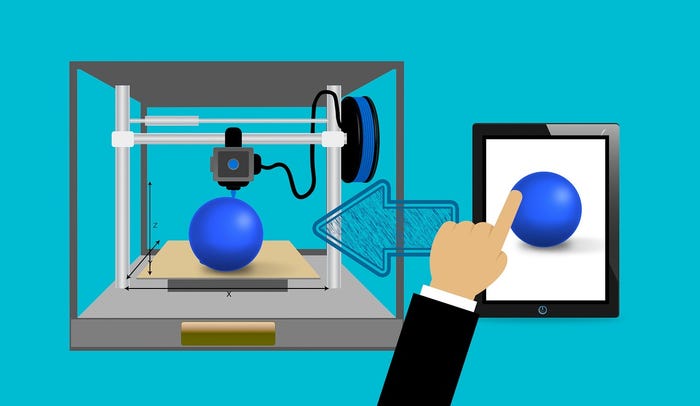The Untold Truths of 3D Printing You Need to Understand
With all of the hype surrounding additive manufacturing and 3D printing, it's easy to forget that, as with all new technologies, there is a learning curve.
April 18, 2019

|
(Image source: mohamed Hassan from Pixabay) |
Additive manufacturing is as guilty as any industry of guzzling its own Kool-Aid and giving people the idea that it's all very, very simple: put in your CAD file, press a button, wait a bit, and here comes your finished part. But as with all new technologies there is always a learning curve required to be able to apply the technology to its fullest.
It helps if we remember the value of any new innovation is directly proportional to the problems it solves, the efficiencies it brings to a process, or the opportunities it makes possible. From that perspective 3D printing is one of the biggest bonanzas of all time. But while many of the companies I’ve worked with have 3D printers, they were bought in a kind of piecemeal fashion. The engineers have their printer, the production people have another printer, and maybe the designers have still another. A genuine three- to five-year additive manufacturing strategy doesn’t exist for most companies; certainly not the smaller ones. And while it’s easy to interpret that as a criticism, it’s not. It’s a reflection on the complexity of the technology as it is today and what it takes to transform your business to fully leverage the benefits of 3D.
Ken Burns, Technical Sales Director at Forecast3D, recently spoke to me about the “untold truths” of 3D printing. The one that really stuck with me is the idea that “complexity is free” in 3D printing. And, of course, it is (sort of). We’ve all gone online and seen fantastic shapes and geometries, and incredibly complex patterns that people have 3D printed. These images do emphasize the crucial differences between additive manufacturing and the traditional manufacturing technologies.
RELATED ARTICLES:
However, Burns, who recently gave a talk called “The Untold Truths of 3D Printing”at the 2019 Pacific Design & Manufacturing Show, said what the images don’t communicate is that 3D printing is now undergoing a complex evolution. 3D printing is transforming from a prototyping and a low production run technology to producing higher volumes of parts in demanding applications in such fields as aerospace and automotive.
So the question becomes: if you print a component or an assembly with a very complicated geometry, will that geometry scale to a large number? In other words ,you printed 10 of something; they came out of the printer looking okay, but not great. The post-print processing to clean up those 10 parts may have been labor and time intensive to make them look great, but that’s okay because you want the customer to see the best 10 printed parts they can get.
Now the customer is so impressed that they want to order 1,000 of them. Now this really complex geometry that you made look perfect doesn’t scale so easily due to the time and labor the post-print processing takes. Whether you run a service bureau or you're bringing 3D printing in house for your own company’s needs, these steps and associated costs have to be taken into account. This isn’t just an issue for a service bureau. It’s just as much an issue for the established manufacturer that is trying figure out how to adopt additive technologies to keep giving customers a reason to do business with them and to stay competitive with start ups that don’t have to bear the cost of these transformations.
Further complicating the matter is the learning curve of designing for additive manufacturing and how it varies from one technology to another and from one material to another. Thermoplastics, resins, and powders all have their unique material properties and the way you design to maximize the benefits for one type of 3D technology and material will be different than how you design for the other. As Burns put it, “Every single additive manufacturing process has different design constraints you need to follow.” Just to give that some perspective and the challenge it represents that means being aware of the design criteria for fused deposition modeling (FDM), stereolithography(SLA), multi jet fusion (MJF), SLS, DMLS, ProJet, and PolyJet. That’s a tall order for any company. And that’s not even all the 3D printing technologies available.
The transformation additive manufacturing is bringing for business in the coming years is going to produce winners and losers. But the transformation is especially challenging given all the variables that have to be considered such as design, which 3D technologies to use, and to what part of the manufacturing process is it best applied. But those companies that take on this challenge and truly think down the road, will not just be winners, they will have survived.
You can hear the full interview with Ken Burns from Forecast3D on the 3DTechTalks podcast below:
ESC BOSTON IS BACK! The nation's largest embedded systems conference is back with a new education program tailored to the needs of today's embedded systems professionals, connecting you to hundreds of software developers, hardware engineers, start-up visionaries, and industry pros across the space. Be inspired through hands-on training and education across five conference tracks. Plus, take part in technical tutorials delivered by top embedded systems professionals. Click here to register today! |
Jack Heslin is the president and founder of 3DTechtalks. A 3D Printing consulting firm helping small to medium size manufacturers develop an additive manufacturing strategy. He is also the host of he 3DTechTalks podcast series. He can be reached at [email protected]
About the Author(s)
You May Also Like




